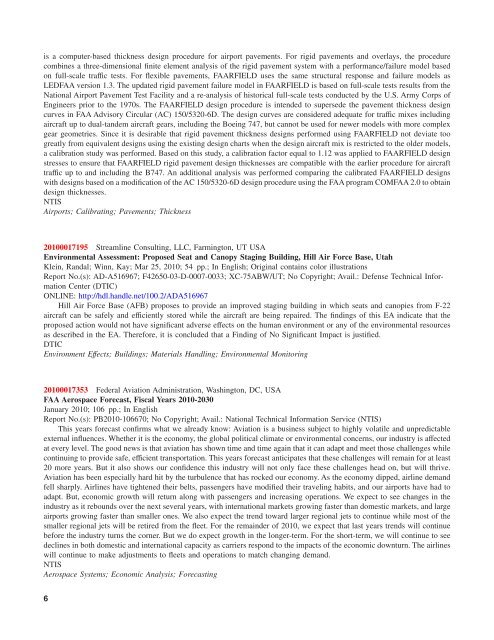NASA Scientific and Technical Aerospace Reports - The University ...
NASA Scientific and Technical Aerospace Reports - The University ...
NASA Scientific and Technical Aerospace Reports - The University ...
Create successful ePaper yourself
Turn your PDF publications into a flip-book with our unique Google optimized e-Paper software.
is a computer-based thickness design procedure for airport pavements. For rigid pavements <strong>and</strong> overlays, the procedure<br />
combines a three-dimensional finite element analysis of the rigid pavement system with a performance/failure model based<br />
on full-scale traffic tests. For flexible pavements, FAARFIELD uses the same structural response <strong>and</strong> failure models as<br />
LEDFAA version 1.3. <strong>The</strong> updated rigid pavement failure model in FAARFIELD is based on full-scale tests results from the<br />
National Airport Pavement Test Facility <strong>and</strong> a re-analysis of historical full-scale tests conducted by the U.S. Army Corps of<br />
Engineers prior to the 1970s. <strong>The</strong> FAARFIELD design procedure is intended to supersede the pavement thickness design<br />
curves in FAA Advisory Circular (AC) 150/5320-6D. <strong>The</strong> design curves are considered adequate for traffic mixes including<br />
aircraft up to dual-t<strong>and</strong>em aircraft gears, including the Boeing 747, but cannot be used for newer models with more complex<br />
gear geometries. Since it is desirable that rigid pavement thickness designs performed using FAARFIELD not deviate too<br />
greatly from equivalent designs using the existing design charts when the design aircraft mix is restricted to the older models,<br />
a calibration study was performed. Based on this study, a calibration factor equal to 1.12 was applied to FAARFIELD design<br />
stresses to ensure that FAARFIELD rigid pavement design thicknesses are compatible with the earlier procedure for aircraft<br />
traffic up to <strong>and</strong> including the B747. An additional analysis was performed comparing the calibrated FAARFIELD designs<br />
with designs based on a modification of the AC 150/5320-6D design procedure using the FAA program COMFAA 2.0 to obtain<br />
design thicknesses.<br />
NTIS<br />
Airports; Calibrating; Pavements; Thickness<br />
20100017195 Streamline Consulting, LLC, Farmington, UT USA<br />
Environmental Assessment: Proposed Seat <strong>and</strong> Canopy Staging Building, Hill Air Force Base, Utah<br />
Klein, R<strong>and</strong>al; Winn, Kay; Mar 25, 2010; 54 pp.; In English; Original contains color illustrations<br />
Report No.(s): AD-A516967; F42650-03-D-0007-0033; XC-75ABW/UT; No Copyright; Avail.: Defense <strong>Technical</strong> Information<br />
Center (DTIC)<br />
ONLINE: http://hdl.h<strong>and</strong>le.net/100.2/ADA516967<br />
Hill Air Force Base (AFB) proposes to provide an improved staging building in which seats <strong>and</strong> canopies from F-22<br />
aircraft can be safely <strong>and</strong> efficiently stored while the aircraft are being repaired. <strong>The</strong> findings of this EA indicate that the<br />
proposed action would not have significant adverse effects on the human environment or any of the environmental resources<br />
as described in the EA. <strong>The</strong>refore, it is concluded that a Finding of No Significant Impact is justified.<br />
DTIC<br />
Environment Effects; Buildings; Materials H<strong>and</strong>ling; Environmental Monitoring<br />
20100017353 Federal Aviation Administration, Washington, DC, USA<br />
FAA <strong>Aerospace</strong> Forecast, Fiscal Years 2010-2030<br />
January 2010; 106 pp.; In English<br />
Report No.(s): PB2010-106670; No Copyright; Avail.: National <strong>Technical</strong> Information Service (NTIS)<br />
This years forecast confirms what we already know: Aviation is a business subject to highly volatile <strong>and</strong> unpredictable<br />
external influences. Whether it is the economy, the global political climate or environmental concerns, our industry is affected<br />
at every level. <strong>The</strong> good news is that aviation has shown time <strong>and</strong> time again that it can adapt <strong>and</strong> meet those challenges while<br />
continuing to provide safe, efficient transportation. This years forecast anticipates that these challenges will remain for at least<br />
20 more years. But it also shows our confidence this industry will not only face these challenges head on, but will thrive.<br />
Aviation has been especially hard hit by the turbulence that has rocked our economy. As the economy dipped, airline dem<strong>and</strong><br />
fell sharply. Airlines have tightened their belts, passengers have modified their traveling habits, <strong>and</strong> our airports have had to<br />
adapt. But, economic growth will return along with passengers <strong>and</strong> increasing operations. We expect to see changes in the<br />
industry as it rebounds over the next several years, with international markets growing faster than domestic markets, <strong>and</strong> large<br />
airports growing faster than smaller ones. We also expect the trend toward larger regional jets to continue while most of the<br />
smaller regional jets will be retired from the fleet. For the remainder of 2010, we expect that last years trends will continue<br />
before the industry turns the corner. But we do expect growth in the longer-term. For the short-term, we will continue to see<br />
declines in both domestic <strong>and</strong> international capacity as carriers respond to the impacts of the economic downturn. <strong>The</strong> airlines<br />
will continue to make adjustments to fleets <strong>and</strong> operations to match changing dem<strong>and</strong>.<br />
NTIS<br />
<strong>Aerospace</strong> Systems; Economic Analysis; Forecasting<br />
6

















